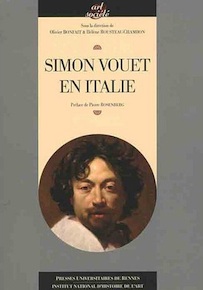Contenu abonnés
Simon Vouet en Italie
Auteur : Collectif, sous la direction d’Olivier Bonfait et Hélène Rousteau-Chambon.
 Les actes du colloque Simon Vouet en Italie organisé à l’occasion de la remarquable exposition de Dominique Jacquot et Adeline Collange au Musée des Beaux-Arts de Nantes [1] sont récemment parus et ne sont pas moins passionnants.
Les actes du colloque Simon Vouet en Italie organisé à l’occasion de la remarquable exposition de Dominique Jacquot et Adeline Collange au Musée des Beaux-Arts de Nantes [1] sont récemment parus et ne sont pas moins passionnants.
Cette rétrospective, malgré les différentes opinions émises par les uns et par les autres sur les œuvres qui y étaient exposées, semble avoir tout compte fait quelque peu clarifié une situation jusqu’alors assez embrouillée. Certes, tout n’est pas résolu et bien des points demeurent encore hypothétiques. Mais tant pour la chronologie que sur les attributions, il semble que dans bien des cas une majorité d’historiens de l’art arrive à une espèce de consensus.
Les actes eux-même sont divisés en quatre parties.
La première s’attache à quelques artistes nordiques actifs à Rome à l’époque de Vouet et aux rapports qu’ils entretinrent avec celui-ci. C’est l’occasion pour Gianni Papi de parler de Honthorst et de dire ce qui le rapproche du peintre français qu’il a sans doute influencé, même si aucune preuve documentaire ne permet d’affirmer qu’ils se sont connus. Il revient également sur Giusto Fiammingo et Jean Ducamps, réaffirmant pour ce dernier son identification avec le Maître de l’Incrédulité de saint Thomas (voir la brève du 23/12/11).
John Gash pour sa part, s’éloignant quelque peu de Vouet, discute d’une des découvertes les plus sensationnelles de ces dernières années, l’identification par Papi de Ribera avec le Maître du Jugement de Salomon. Cet essai recense les arguments favorables comme ceux défavorables à cette hypothèse. Il en conclut, après avoir vu l’exposition de Madrid consacrée au jeune Ribera, que plusieurs tableaux du groupe attribué au Maître du Jugement de Salomon seraient effectivement du peintre espagnol (notamment Le Christ discutant avec les Docteurs, Le reniement de saint Pierre et La résurrection de Lazare), mais pas le Jugement de Salomon lui-même ! Cette question devrait faire encore couler beaucoup d’encre.
-

- 1. Attribué à Simon Vouet (1590-1648)
Ange expliquant les mystères divins à
Marie-Madeleine auprès du tombeau du
Christ
Huile sur toile - 136,6 x 112,4 cm
Rome, collection particulière
Photo : D. R. - Voir l´image dans sa page
Erich Schleier est l’auteur, dans la deuxième partie (« Vouet en Italie, échanges et réceptions »), d’un article consacré aux rapports entre Lanfranco et Vouet. On s’attardera ici sur une note [2] où celui-ci semble regretter que nous l’ayons attaqué « assez viole[mment] » dans notre article consacré à l’exposition à propos de sa notice sur le tableau cat. 29, Un ange expliquant les mystères divins à Marie-Madeleine auprès du tombeau du Christ (ill. 1), et s’en explique longuement. S’il est exact que notre critique était assez vive, elle ne se voulait pas violente et nous regrettons qu’elle ait pu être ressentie ainsi. Erich Schleier précise que ses informations sur la provenance de ce tableau étaient tirées d’un article d’Anne Rivoallan paru…
